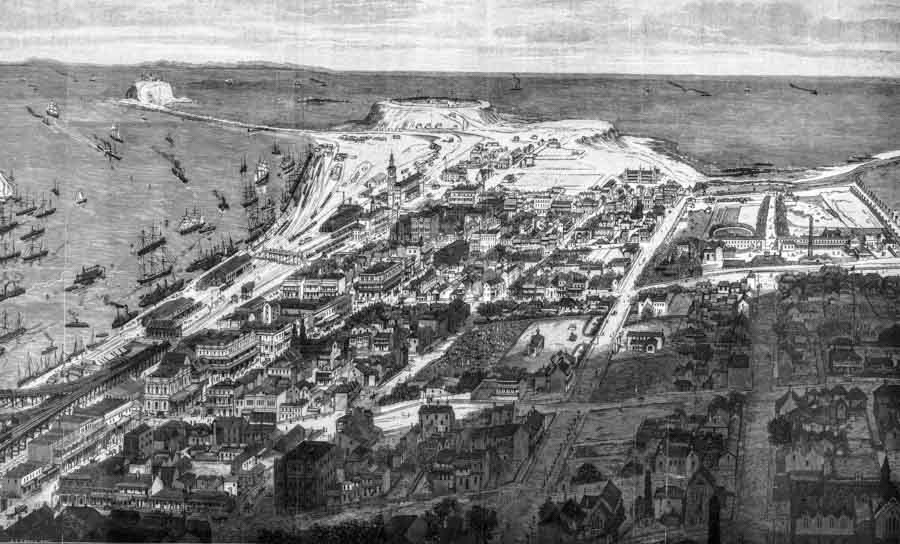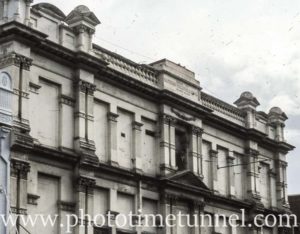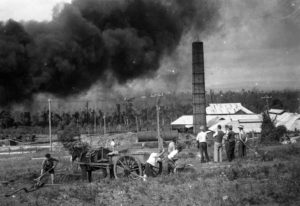Some years ago Mrs Margaret Thompson was visiting an elderly aunt to gather information for some family history research. A request for old photographs brought to light an old black exercise book in which the elderly lady’s father, the late Robert Sneesby, had recorded many of his recollections of Newcastle in the late 1800s. Recognising the treasure, Mrs Thompson and her husband Stuart transcribed the document, added numerous photos from various sources and made a handful of copies. Some months ago she kindly loaned me a copy to scan. A copy of her transcribed document was lodged with Newcastle Region Library. I have lightly edited the document as it appears below for the sake of clarity. Mr Sneesby’s recollections are a delightful window into a lost world, full of interesting insights into the Newcastle that was, and the people who lived there.
Robert Cobbin Sneesby died on May 5, 1942, aged 79. Robert had been a plumber by trade, establishing a firm that is still in existence today [at the time of Margaret’s writing]. He worked on the building of the Gosford Railway Station and Newcastle City Hall. He was a member of Wickham Council for many years. He wrote this document in 1940. My occasional comments are inserted in square brackets: [thus].
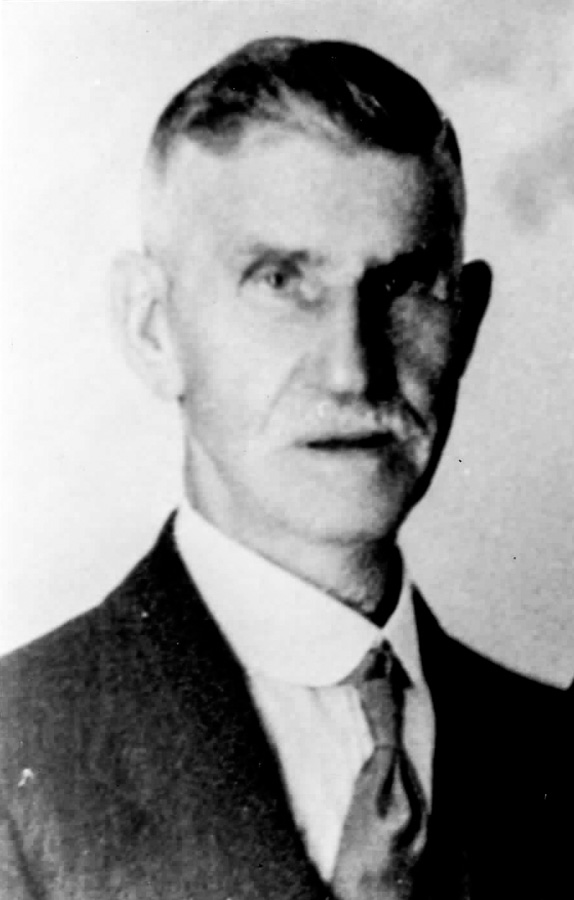
I think I have recalled to my memory many things. I hope you will overlook any repetitions or faults I may have made in spelling or writing.
Robert Cobbin Sneesby
I, Robert C. Sneesby, was born on March 6th, 1863, at Railway Street, Newcastle. I was a twin son of Mr Henry Sneesby who came to Newcastle to live in 1857 after losing all he possessed in a big flood in July, 1857, at Millers Forest where he had rented a farm on the Scotch Creek from a Mr Hickey. He came to Newcastle and went to live in a brick house in Railway Street. It was there that my twin brother (the late Sydney H. Sneesby) and I were born. (My brother, Sydney, died at Concord, Sydney District, October 5th, 1932.)
About the year 1865, my parents moved to a cottage at the corner of Pitt and Dawson Streets. The building, which was originally a Baptist Church, was remodelled and made into a five-roomed cottage by its owner, Mr James Dart. (Father of Mr James Dart, Solicitor, of Newcastle, who is at this time the oldest solicitor in Newcastle.) The Church was the first Baptist Church in Newcastle. Mr Dart’s father owned most of the property in Pitt Street (now named Queen Street).
In 1871 we moved to a property my parents bought in Bruce Street, near Newcastle Cricket Ground. My father built a new home there and they lived there until father died in 1898 and mother followed in 1906. My father was secretary for the Newcastle and District Benevolent Society.
My first memory was of going with my parents and twin brother, Sydney, to see the Coal Arch built near Steamer Wharf, for the Duke of Edinburgh to go through in the year 1868. I remember going through it with my parents. At night time there was a big fire made. The fire was of coal. In those days there was no gas or electricity to have illuminations. At the end of the present Dyke was only sand, and the government was filling it with ballast which was taken from ships from overseas so wharves could be built.
I remember most of the old buildings in Hunter and Watt Streets. The Great Northern Hotel was only a small building. Also McCloudys Hotel (now the George Hotel) was only one storey. There was Chadwicks Hotel which went across where Hunter Street is now going to the beach and Hospital. This Hotel faced straight down Hunter Street, which went only to Watt Street.
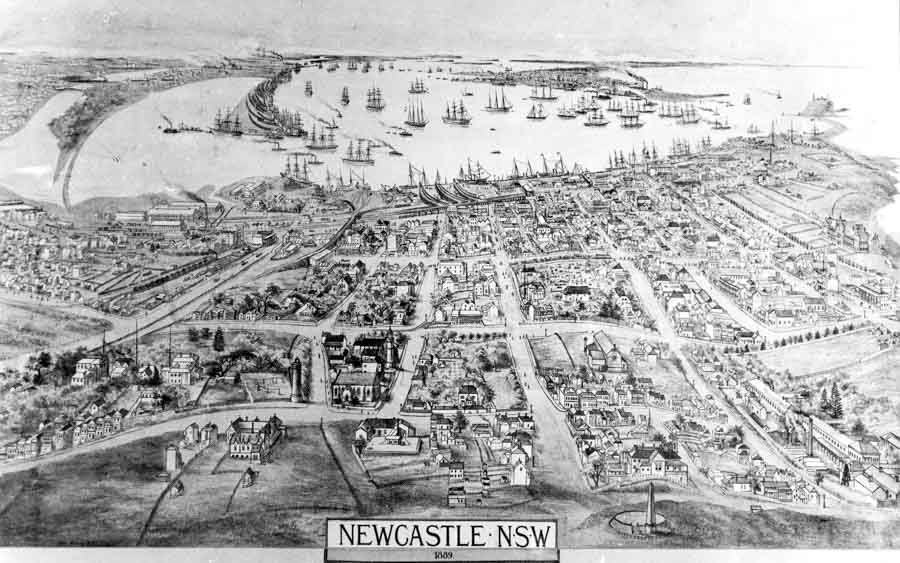
I remember when all coal was shipped in Newcastle. It was by means of staiths built to higher level from low level beginning at where Winn & Co is and Bank of Australasia and opposite Brown Street, and so built as to enable the coal to be shipped at the wharves by chutes. The coal was filled in eight or 10 waggons and pushed up the incline by a locomotive to high level and gravitated to the different chutes made for loading the vessels. These staiths and chutes went along the frontage of Hunter Street and the wharves from Brown Street crossing to Market Street near where Shortland Hotel is. There was also coal shipped opposite where the Customs House is and fronting the harbour by about six steam cranes. The foundations of these can be seen under the wharves going toward the Pilot Boat harbour coming back to Hunter Street. I remember seeing a timber yard where the Criterion Hotel now stands [now the site of the tall glass-faced State Bank building on the corner of Hunter and Bolton Streets. GR]. It was leased and managed by Mr W. Knight. Also when Mr Hubbard kept the Yacht Club Hotel. he had his livery stables at the rear and also had a large area of land in Watt Street where Messrs Howard Smith’s large building is now.
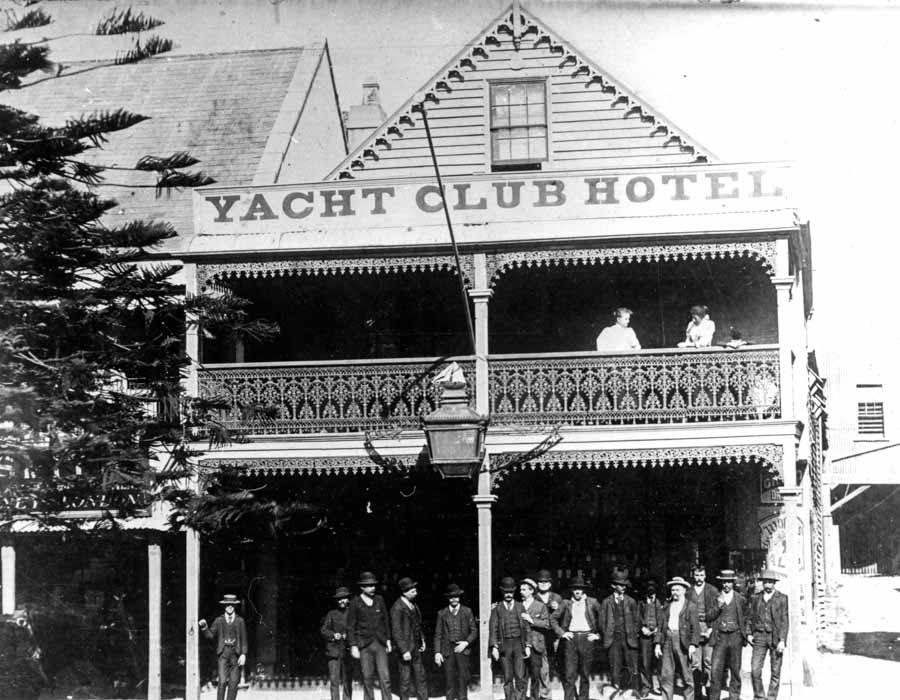
Also where the Bank building at the corner of Bolton and Hunter Streets is now erected was an hotel kept by Mr Kerkaldy – afterwards extended and used as a branch of the Bank of New Zealand. There was also a two-storey weatherboard hotel between Bolton and Watt Streets kept by Mr J. Hubbard.
Where the present School of Arts now stands there was vacant land. The School of Arts was built back to railway property which abutted it. Wolfe Street went only to the railway fence. This School of Arts was burnt down and the present building erected facing Hunter Street and Wolfe Streets. I recall a timber yard where the centre of Messrs W. Winn & Co faces Hunter Street. It was owned by a Mr M. Nolan. Afterwards Mr Nolan built the Paragon Hotel where the timber yard stood.
There was a large galvanised iron building erected where Messrs W. Winn & Co building now stands on the corner of Brown and Hunter Streets. Mr Gates kept a grocery business there. It was burnt down and then the Hunter River Hotel was erected in its place. This hotel was kept by Mr A. Kerkaldy. At the rear, on land facing Brown Street corner, Messrs Moyes and Donald had a large engineering works. This property is now occupied by Messrs W. Winn & Co. Also on the corner of King and Brown Streets, Mr W. Henderson had a timber yard. It was moved to the opposite corner where Messrs J. Barker building are now erected and in place of it Mr Henderson erected a large brick building which Messrs F. Ash occupied until they erected their own new buildings in Hunter Street West opposite Merewether Street.
At the corner of Brown and Hunter Street West of Messrs W. Winn was the old Bank of Australasia. This company owned the block from Brown, Hunter, Crown and King Streets.
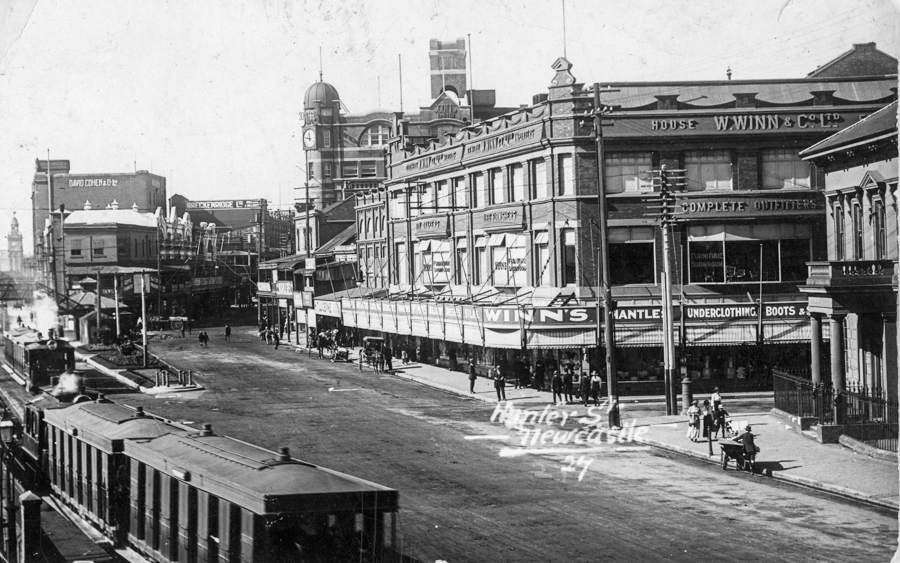
On the corner of Crown Street there was an old galvanised iron one-storey hotel. It had a half round shaped roof. The shape of the building was like a cottage with gable end and verandah in front of the residence. The gable was built up to street. This hotel was kept by Mr Abernathy. Where the bar was many years ago, the Banking Co sold the corner to Messrs J. Ireland. They built a large grocery premises which was again pulled down and the present Oxford Hotel [now the Lucky Country] stands. Messrs R. Bryant and Messrs Lewis and Thomas bought frontage to Hunter Street between the Bank and Messrs J. Ireland’s property.
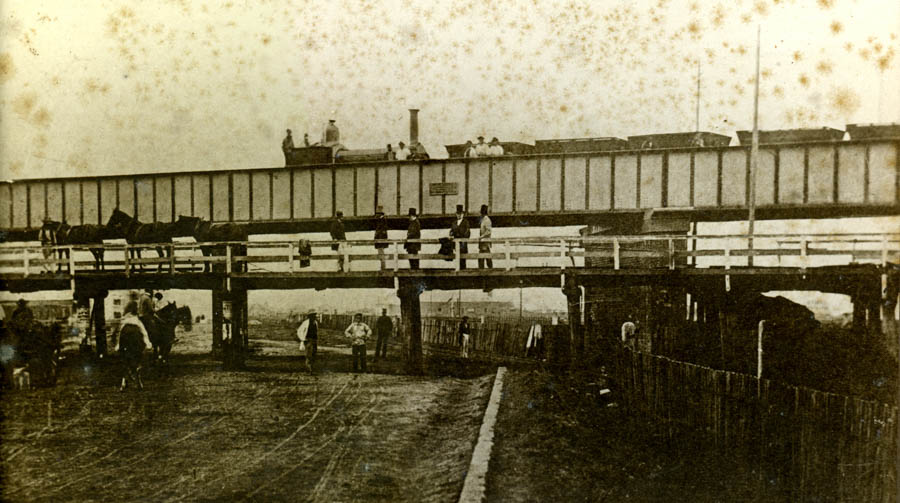
Hunter Street only went to the Iron Bridge which the A. A. Co erected to convey their coal across to Harbour front to their staiths. The bridge went across where Messrs Cox & Co (late Walter Neve) building is erected. The street past the bridge was named Blane Street and went as far as Cottage Bridge or Bank Corner and then to the high level bridge across the railway between Newcastle and Islington. This street was named Charlton Street. In my young days there was no bridge. There were gates crossing to Islington. They called them the White Gates.
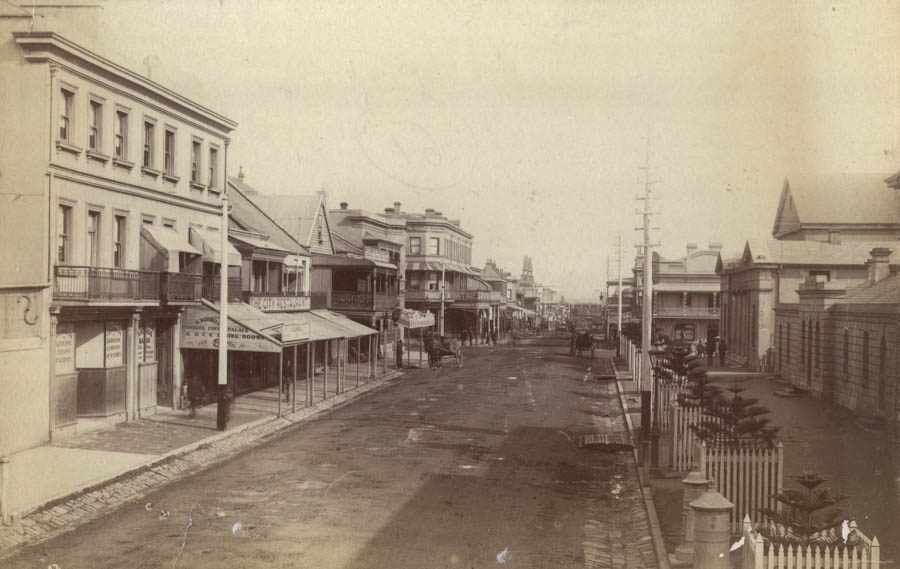
Returning to Hunter Street: that was the shopping part of the town. There were very few shops – only small fruit shops, hotels and butcher shops and vacant land and private homes. The Post Office was at the corner of Hunter and Watt Streets – now the Public Works Offices. The Police Station was only one storey. The Court House was at the corner of Hunter and Bolton Streets northside. The old Ship Inn on the opposite comer was kept by Mr M. Lister.
At the corner of Hunter and Newcomen Streets, where the Cash and Carry are now trading, the old Steam Packet Hotel stood. At the rear, down Newcomen Street (where the old Baths was erected) was a reserve where the town pump supplied the water from a deep well for street watering and also for drinking purposes and at the opposite corner of Newcomen and Hunter Streets was the Crystal Palace Hotel, occupied by Mr and Mrs J. Anderson who years afterwards owned the Crystal Palace Gardens and Hotel, Hanbury Street, Mayfield.
There was an Hotel named Rouse Family Hotel and kept by Mr W. Rouse. It stood back from Hunter Street and was situated where Messrs Washington Soul & Co and part of Scotts building now stands and nearby west were two small brick shops kept by Mr Grisdale. Next-door to that – on the corner of Hunter and Perkin Streets – was a two-storey weatherboard butcher’s shop owned and kept by Mr Hickinbottom. On the opposite side west where the Crown and Anchor Hotel is now erected, was vacant land. Years afterward Mr R. Cuthbertson had a monumental works there. Before moving to that position he was on the opposite side of Hunter Street next to where Messrs Johns & Co premises are situated. Scott Street did not come through then. The government railway came right up to the rear of Johns.
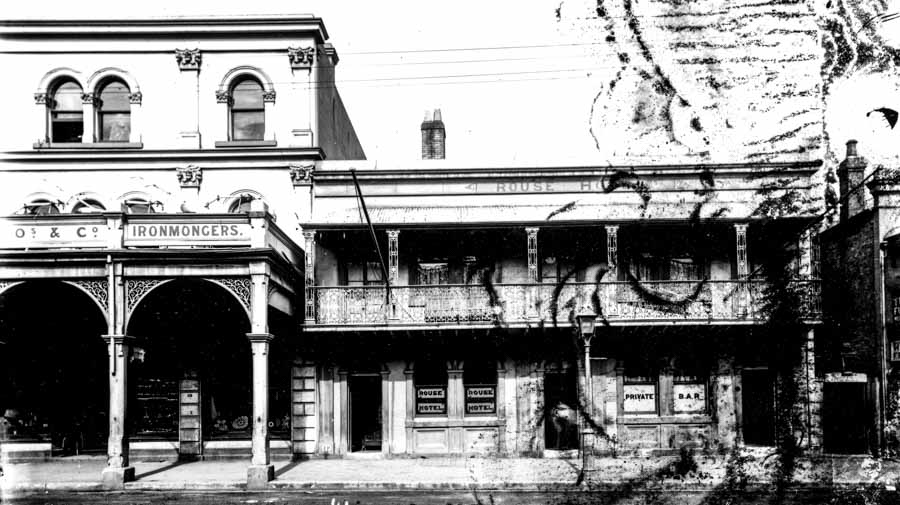
Scott Street only came to Market Street. Scott Street extended from the rear of the Great Northern Hotel to the Great Britain Hotel in Market Street. Messrs John Burke, produce merchant, and Mr Harry Stegga had two small weatherboard gable-end premises where the Shortland Hotel now stands. Facing up Scott Street and abutting railway property was a one-storey shingled hip roof and verandah hotel named the Market Hotel – kept by a Mrs Hope and then years later by Mr J. Peterson. The outlet at Market Street for Scott Street was about ten feet wide.
At the rear of the Great Northern Hotel, the whole of the land and right up to the sea front east, south and to the Harbour front, was sand. Paddocks were formed and fenced to keep the sand from drifting from Newcastle Beach. There were two small cottages built facing west on the Hill East front of Ocean and Captain Allen Hill (now the Fort). The old gaol stood where the old tram sheds were erected. I remember going through the ruins of the gaol.
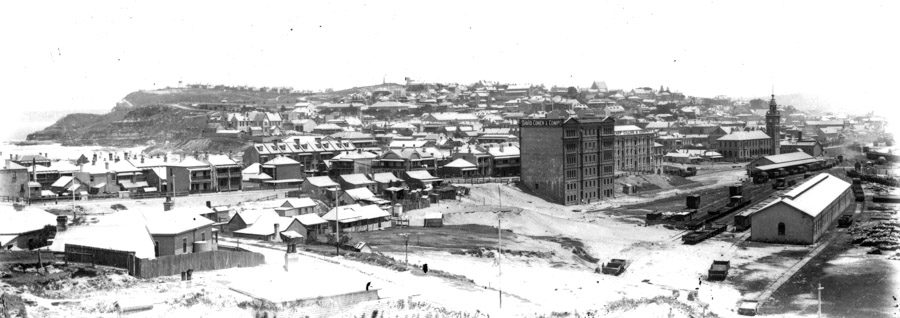
In Watt Street there was the Great Northern Hotel, then a very small building, then an old building used by the Bank of NSW, a few weatherboard shops and then Mrs Chadwick’s Hotel, which went across where Hunter Street goes through now to Telford Street. Next were Mr Field’s butcher shop, the Oriental Hotel and two old brick buildings with a lane at the side and the old theatre where Dr Gardner’s surgery is at present. I would like to mention that I remember going to see an entertainment at the old theatre – a Madam Corza was entertaining. Then there was Mr Blackenston’s Hotel and vacant land on the corner of King and Watt Streets. On the south side of King Street and Watt Street was an old hotel. Mr Porter owned this property.
The way to go to Newcastle Beach was by Watt and King Streets and by the Hospital Grounds. It was also the way to go to Newcastle Hospital which faced down King Street. On the corner of Scott and Watt Street, opposite the Great Northern Hotel, was McCloudys Family Hotel (on the site where the George Hotel now stands). Next to it were two small weatherboard buildings and then on the corner, the Post Office corner of Hunter and Watt Streets. On the opposite corner a small brick bank and a lane. Where Messrs Howard Smith’s offices are now built was a fenced-in paddock rented by Mr Hubbard who kept the Yacht Club Hotel facing Hunter Street. Mr Hubbard had a livery stables and cabs on the paddock at rear. Mr Sparke had a butcher shop next door. Mr H. Berkley’s father and mother had a fruit shop. Close by, on the corner of King and Watt Streets south, was vacant land owned by Mr John Ash.
Industrial school for unruly girls
Where St Philip’s church is built there was only weatherboard cottages owned by Mr Hyde. An eccentric old woman named Judy Daniels lived there. It was said that she was the ugliest woman in Newcastle and if you met her it was bad luck, but the remedy was to spit over your left shoulder and pass on. Next to this property, where the large terrace of houses right up to Church Street and halfway down to Bolton Street are now, was the property of the adherents of St Andrew’s Presbyterian Church who now have the new church at Laman and Auckland Streets, Cooks Hill. St Andrew’s church was first built and used by the Presbyterians. The Church was built of brick with a small square tower and on the corner was a large wooden building where the minister, the Rev. J. Coutts, lived. I remember working as a boy in the church with a man. We were doing some repairs. I might mention that St Philip’s Church congregation was domiciled where Messrs Cohen & Co’s large warehouse is situated next to Shortland Hotel and warehouse but at the rear of Messrs Elliott & Co Tailors’ shop which faced Hunter Street. The entrance to the Church was by a carriage drive also facing Hunter Street and on the corner of Thorn Street. Messrs J. Breckenridge occupied a building which was erected on this carriage drive years after. The present Mental Hospital was used as an Industrial School for unruly girls. I often heard as a boy that some of the girls had escaped.
Returning to Hunter Street, I would like to say that I have seen the old buildings pulled down or burnt down and more up-to-date buildings erected in their place. Blane Street began west of the old Iron Bridge which has been demolished. There were no shops or buildings on the north side. There was the government railway and workshop and the old Honeysuckle Station in the railway yard at Auckland Street and the two old cemeteries near Cottage Bridge. On the south side of Blane Street, starting from Iron Bridge, there were two small wooden buildings, one occupied by Mrs Nicholls (known by most people as Gentle Annie) and years later another small shop. The late Mr Raysmith, watchmaker and jeweller, began business in Newcastle. He was then known as Mr Thomas H. Smith, his real name. As there was another Mr Thomas Smith, a contractor, their letters got mixed so Mr Thomas Smith – watchmaker – changed his name to Raysmith.
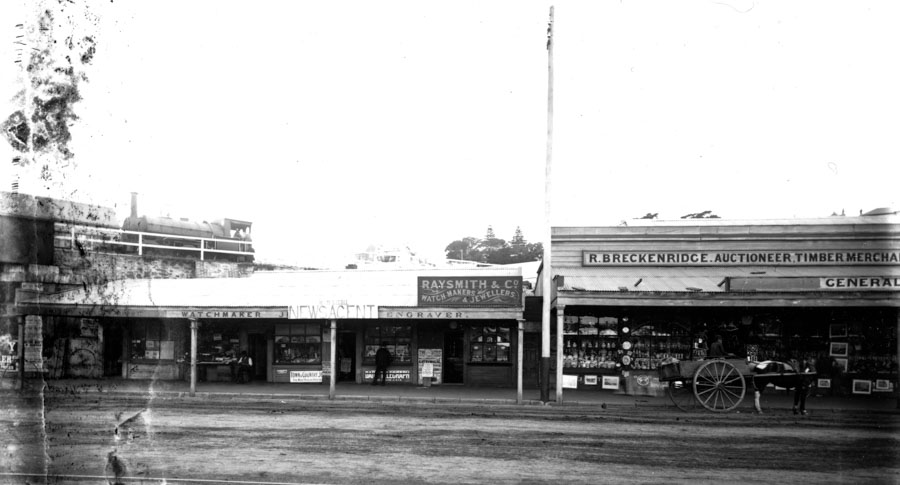
Next door to Mr Raysmith Mr Robert Breckenridge leased the whole of the property from Iron Bridge down to the old building now known as Tattersall’s Corner, Darby and Blane Street. Mr Breckenridge had a timber yard and office and also a large paddock. There was a lean-to fruit shop against the Tattersall’s building. This was occupied by a Mrs Canavan, then came Jenkin’s furniture shop and undertaker. Next-door between Tattersall’s Hotel and Jenkin’s was a doctor’s surgery occupied by Dr Degner and then the hotel on the corner. The first licensee I forget, but Captain D. Brent occupied it for a number of years.
The land known as Breckenridge’s Paddock was often covered with water in wet weather. I have seen many Circus people pitch their tents there. I remember seeing one very fine circus there – Chereneys. They had five beautiful black horses which went up on their hind legs and paraded around the ring at their master’s command, besides other very interesting items.
On the corner of Darby and Blane Street West down to where Messrs F. Ash & Co’s warehouse is built was vacant land, the old Copper Co Railway line dividing it. Mr W. Sparke, butcher, built a very nice home near where Messrs F. Ash & Co now stands and next door where Wheeler Place is and Civic Theatre was the late John Brown’s father and mothers’ property who had a very nice home there (I might say here that I have often seen Mr & Mrs James Brown (Mr John Brown’s parents) and also Mr Alexander Brown, brother of Mr James Brown and uncle to John, also his three brothers James, William and Stephen Brown and sister Mrs Nairn. I have often seen Mr and Mrs James Brown getting into a very nice Brougham waiting in Blane Street at the front of their home and driven away by coachman for their morning outings).
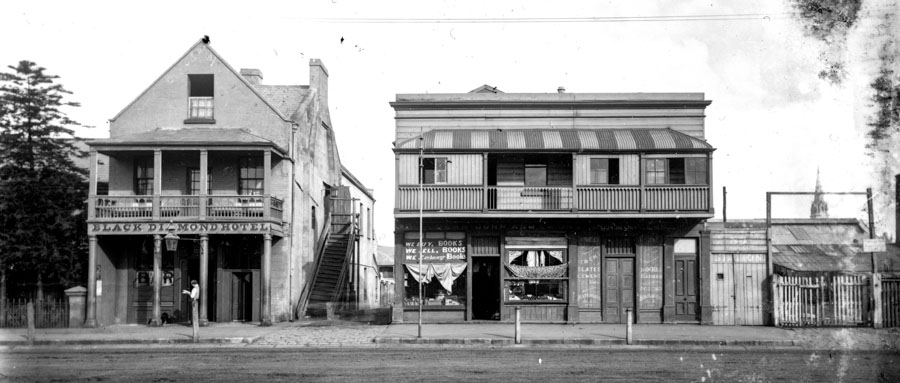
Next to Mr Brown’s residence was the old Black Diamond Hotel kept by Mr R. Hackworthy and large block of vacant land owned by Messrs Brown. Messrs John Ash and sons built a big sawmill and joinery works. Also a two-storey weatherboard shop and dwelling which Messrs Ash occupied as an ironmongery store (I looked after that shop when I first went to work in 1876. I was there for two and a half years and then went to learn my trade.)
Next door to Messrs Ash’s timber yard was the old Post Office Hotel kept by Mr J. Wilson. Next to that was vacant land down to Mrs Breckenridge’s drapery shop a two-storey weatherboard on the corner of Blane & Auckland Streets. On the opposite corner Mr J. Witherspoon had a grocer’s shop. Vacant land ran down to Mr W. Sparke’s butcher shop and next-door was a small weatherboard shop and dwelling.
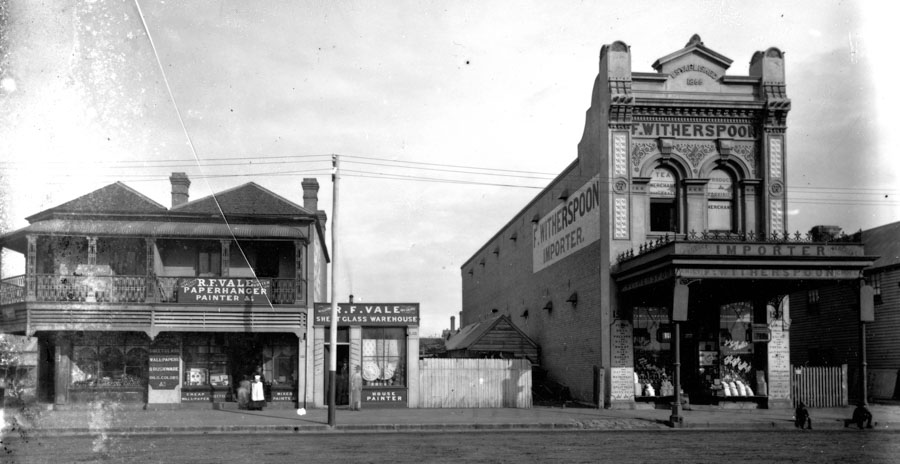
Mr Hartley Spurr occupied it and opened up business as a fish shop. Then there was the old Victoria Hotel occupied by Mr Collins. A little lower down was a two-storey weatherboard building occupied by Chinese cabinet makers and two small weatherboard cottages owned by Mr J. Tayler.
From there on was property owned by Mr P. Fleming Senior. At the rear there is a terrace of brick cottages owned by Mr Fleming. Mr Henry lived there for some years and he built a nice home on land near Throsby Creek north of the present Carrington Bridge at Maryville-Wickham. The land in front of Mr Henry’s terrace and fronting Blane Street down to Union Street was vacant land. There was vacant land on the opposite corner and then Rev W. Bain built two two-storey brick residences.
Then Captain Henderson owned two brick residences, then was vacant land and Mr Hinton owned a weatherboard house which stood back to Devonshire Street. On the west corner of Devonshire Street was vacant land. Then was the old Star Inn kept by Mr H. Cameron.

Where Messrs Light’s property is now built Mr J. Hannell owned three brick houses. Then was a small weatherboard school. Vacant land facing Blane Street; three small attic two storey cottages stood well back and then more vacant land. Part of this land, which went through to King Street, was a running track where the Water & Sewerage Board buildings is erected. Next door was an old weatherboard one-storey dwelling and fruit shop. Mr James Porter became owner of this property. He erected the three-storey shops which now occupy the site. Next door were two brick residences and where the Newcastle Gas Co offices are erected Mr Richard Owen had a blacksmiths shop. When the Honeysuckle new station was built opposite Mr R. Owen erected the buildings which still remain there. It was called the New Station Hotel.
On the corner of Steele and Blane Street on both sides was vacant land. Wwhere the Empire Hotel is now built was vacant land and next door west was Mr Pestell’s Boot & Shoe Shop and then vacant land to where the Theatre Royal stands was a nice brick home of Mr James Hannell. From there on to Cottage Creek was vacant land, until the late Mr John Gilbert bought the land through to King Street. The Creek divided it in the middle. On the opposite side of Blane Street between Cottage Creek and Honeysuckle Station was two burying grounds – the Presbyterian and Roman Catholic.
Going east towards Newcastle and east of Goodsheds and where the Technical and old Trades Hall from end of Goodsheds to where the old mortuary station was built.
The tidal water came right up to Blane Street. It was deep water to the railway line. I have often been on the sand at low water. There were two small cottages built where Messrs McGrath and the public conveniences are now built. The yards at back was water when the tides came up. Around towards where Lee Wharf is was a nice sandy beach and right around the harbour-front of Inner Harbour was sand right through to end of the Dyke and near where A.A. Coy wharf was situated.
Bullock Island was bush and swamp
There was no way of going to Bullock Island other than by rowing boat. I have seen the sandbanks with a stream of water from Throsby Creek which went right around the west side of Bullock Island to the harbour near the steelworks.
I have been with a Mr Matthews at Tighes Hill right around Carrington through to Walsh Island in a boat. In the early days the island was a sandy flat. When we went fishing, we went on the sandy flat to get bait. I remember Bullock Island when there were no houses – only bush and swampy land. Before any bridge was built across from Newcastle to it a Mr Howden – a shipwright – had a workshop or slip there. He always went across by a boat. He was drowned when he was trying to get into his rowing boat near Honeysuckle Station. He lived at Darby Street (Lake Road). He owned property there where the Jones Dance Hall was situated. He was Mr James Rodgers’ father.
I remember going to Bullock Island with my uncle, Mr Matthew Cobbin, who had the contract to take the ballast from the shipping which came from overseas to load coal which was then at Newcastle. The dyke was only sand and was being formed by the stones and earth from overseas which the vessels brought and as there was only jetties where the vessels unloaded large baskets and emptied into trucks and then drawn by horses along the temporary line and spread and formed the present dyke.
My uncle took his horses to the island by swimming them across at the rear of his rowing boat. Every Monday until Saturday he stabled and fed them over there, bringing them back each weekend. I have been on the Dyke seeing him doing the work as a boy with my brother Sydney. Mr Cobbin lived at Belmont. He owned a property of 100 acres and went home each weekend and back to Newcastle on Mondays. He sold out his business at the Dyke in the 1880s to a Mr Parkinson and went to live at Belmont on his property.
I remember going out to Belmont when I was eight years old with my uncle. There was only bush tracks and it took us two and a half hours to get there. This was in 1872. Now it only takes twenty minutes to go by car.
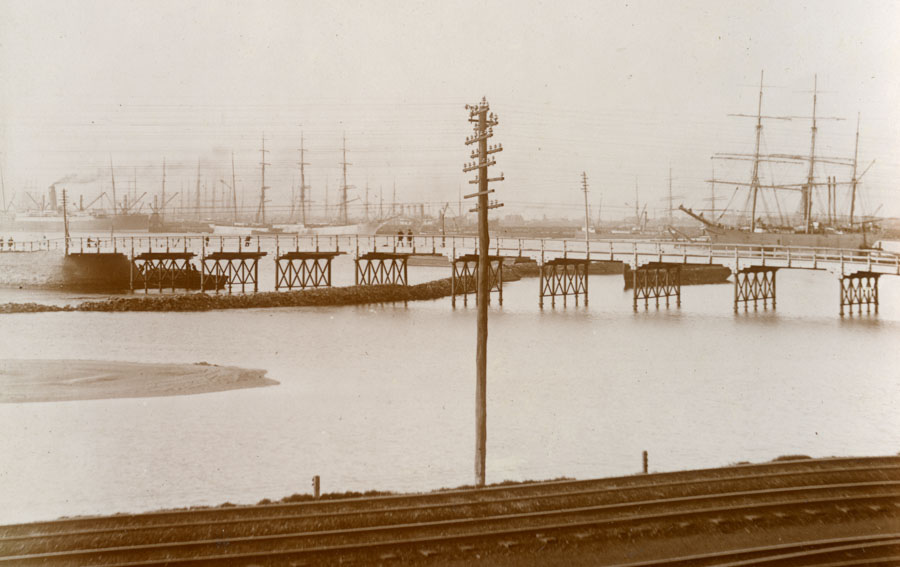
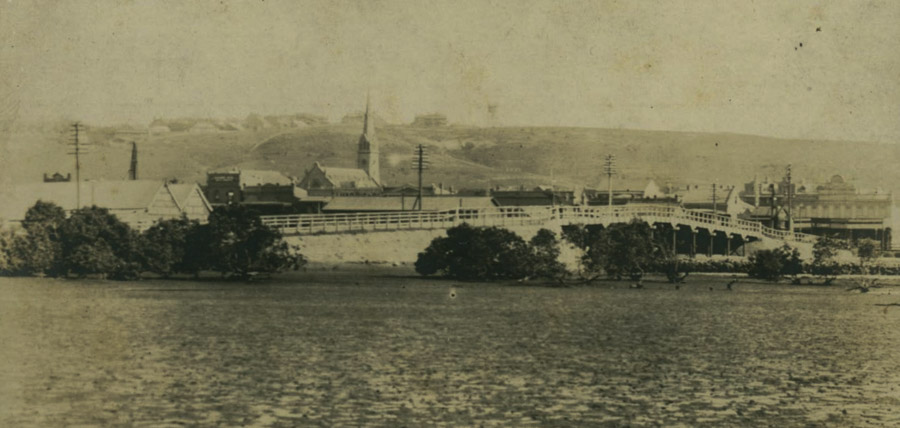
I remember the first bridge that was built to Carrington. The first bridge was constructed between Newcastle and Bullock Island where the public conveniences are now are built, on the street where Miss J. McGrath’s business is situated in Hunter Street West and from there to where the wheat silos are now. The bridge was a low wooden bridge and a much better bridge was built for heavy traffic years afterwards. This bridge was taken away some years afterwards and a bridge built from the Wickham side opposite St James Church of England. This was again taken away and built where the present traffic goes over to Carrington. This was after the coal line and bridge was taken away.
There were two coal pits at Bullock Island – the Hetton Colliery right in the middle of Carrington near the wharves and the Wickham and Bullock Island Pit where Messrs Armstrong and Royce Sawmills are situated. This is now Messrs Woodcock Beveridge and Co.
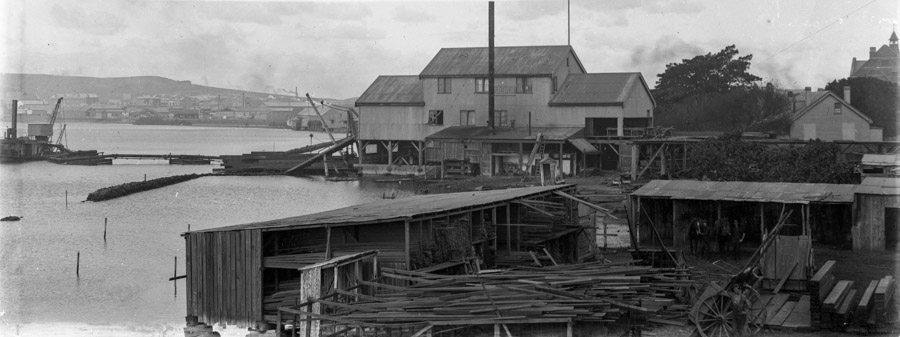
As a boy when my parents lived at Pitt & Dawson Street I often sat with my brother (Sydney) where the Baptist Tabernacle now stands. It was vacant land halfway between Dawson Street and Pitt Street. There was only a small track to go to Darby Street. It was a nice green hill and slanted down fairly steep.
The A.A. Coy line went along from their staiths and property behind where Sorby & Co and other businesses are along King Street. This railway went out to two pits along past the rear of Cooks Hill, Gas Works Hill and through to Hamilton.
Waterhole for horses at Darby St
The Copper Company Railway divided Prossers Hill, now Cooks Hill, and Dart’s Hill (the Hill I just mentioned) and went from Government Railway across Blane Street near Darby Street. This railway line still exists and goes out to Glenrock, but in the early days it went to a copper works where the present sewerage farm is between Merewether and Glenrock. These two railway lines caused land to be water holes between Darby Street and the Copper Smelting Co line at the foot of Darts Hill and the A.A. Co line and from the A.A. Co line to Lower Church Street, now King Street. This street was only grass and earth. There was a very large waterhole and from Lower Church Street to Blane Street was also a waterhole. The waterhole near Darby Street and Dart’s Hill was where all the teamsters took their horses to have a drink as they came from the brickyards at The Junction and as they passed back from Newcastle to The Junction with their empty carts. Pressers Hill (now Cooks Hill) and Dart’s Hill are now connected by an iron bridge.
As a boy with other lads I often played cricket on Prossers Green which extended from where the late Dr Ferguson and then his widow lived to Bull Street. Council Street was not formed then.
This Hill was so named after a builder and contractor named Prosser who sold out to Mr Thomas Cook’s father who owned a large property at Torrenville, Scone. Mr Prosser built the home and outhouses which is still standing near the St Andrew’s Presbyterian Church. When Mr Cook came to live there the hill and green became known as Cooks Hill. Mr Prosser built two houses in Darby Street and a workshop at the rear near St John’s Church of England.
Mr and Mrs Cook who died at their home in Cooks Hill used to go to St John’s Church. There are two very nice stained glass windows erected to their memory by their son, Thomas, at St Johns. I remember seeing them at the church.
Darby Street was swamped by sand
I might mention that Darby Street was known as Lake Road. In the early days that was the main road to Belmont and Lake Macquarie. There were no roads between Darby Street and Adamstown. The Copper Company Railway to Glenrock was used by pedestrians.
Bruce Street was only half road from Prossers Hill, and Bruce and Corlette Streets both finished at Bull Street. Melville Street or Union Street was not formed. Melville Street goes through now to Merewether. It was swamp and thick bush back then.
Parry Street was not formed. It was swamp land from Darby Street at Bruce Street to where Melville Street and Corlette Streets intersect. It was 12 feet deep lowland. When Parry Street was made to cross to where Melville Street now is there was a big barrel drain built midway between Corlette and Bruce Streets. This drain was 10 ft x 8 diameter. It was made to take the water which comes by drain from near Peters Ice Cream Co Factory. There is a large barrel drain that crosses Darby Street near the Police Station. This drain was taken through swamp lands south of Parry Street through to Cottage Creek Drain near No. 2 Sportsground. It takes the storm water from the hill east of Darby Street.
The natural sand was taken from Darby Street sand-drift south of St John’s Church. The area east of Darby Street from Tooke Street was covered with the sand-drift which covered Darby Street – or Lake Road as it was called in those days. I have seen six fences erected to keep the sand back – one on top of the other. The sand often was blown by the southerly gales right across the street right up to the cottages erected there and Darby Street had to be cleared by the Newcastle Council workmen to allow traffic to pass. I have seen grass and bush growing also trees up to the Bar Beach. I remember going to a church picnic on nice grassland and trees overlooking Bar Beach.
The sand from Lake Road sand-drift was taken by a temporary line in skips to form Parry Street from Darby Street to where Number 1 Sportsground also Melville Street to across to Kemp Street Junction. The low land between Melville Street was filled in many years after Melville Street was made. It was thick bush across to the racecourse. They made a temporary road afterwards to the racecourse. The way to go to the racecourse was across from where West End Park is now. That land was also low land and often covered with water.
The sand-drift was caused by clearing the low brush and trees from the sea front. It cost the Newcastle Council a lot of money to clear the only way to the Lake.
Tales of shipwrecks
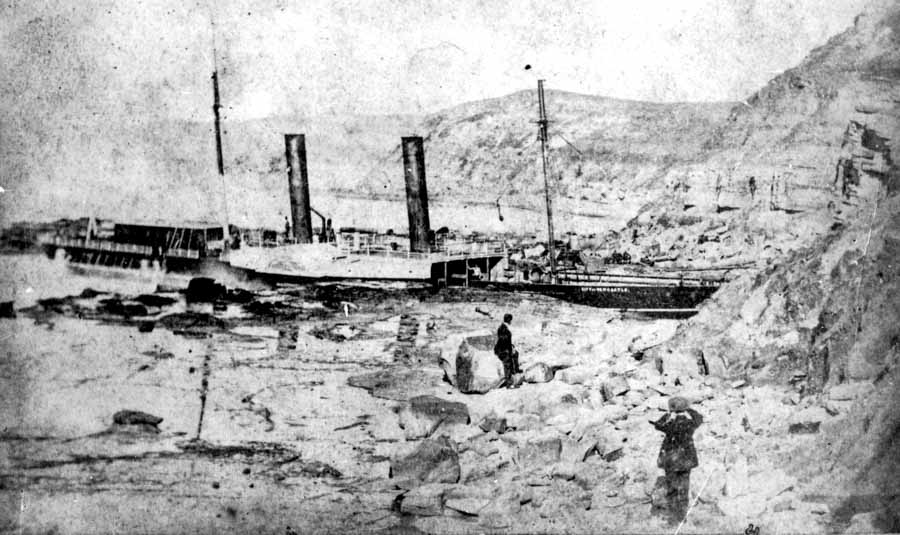
I remember when the steamer City of Newcastle was wrecked under Shepherds Hill about the year 1878. I went to see her a few hours after she went onto the gulf and alongside the flat rocks. She looked quite cosy. They placed a couple of wide planks to enable the passengers to walk ashore on the rocks. I was about 14 years old. I went aboard her. There was no loss of life. The mishap was caused by fog. Old Mr Merewether was a passenger and they used to say he was wanting a short cut to get home.
I also remember the Susan Gilmore which went ashore about 1/4 mile south of where the City of Newcastle went in. The Susan Gilmore was also wrecked through fog (gale). I remember going up to see her full rigged lying close to the shore. I saw the captain jumping overboard and swimming to the shore. He had a line and then they fastened a stout rope and a basket in which the crew was brought ashore.
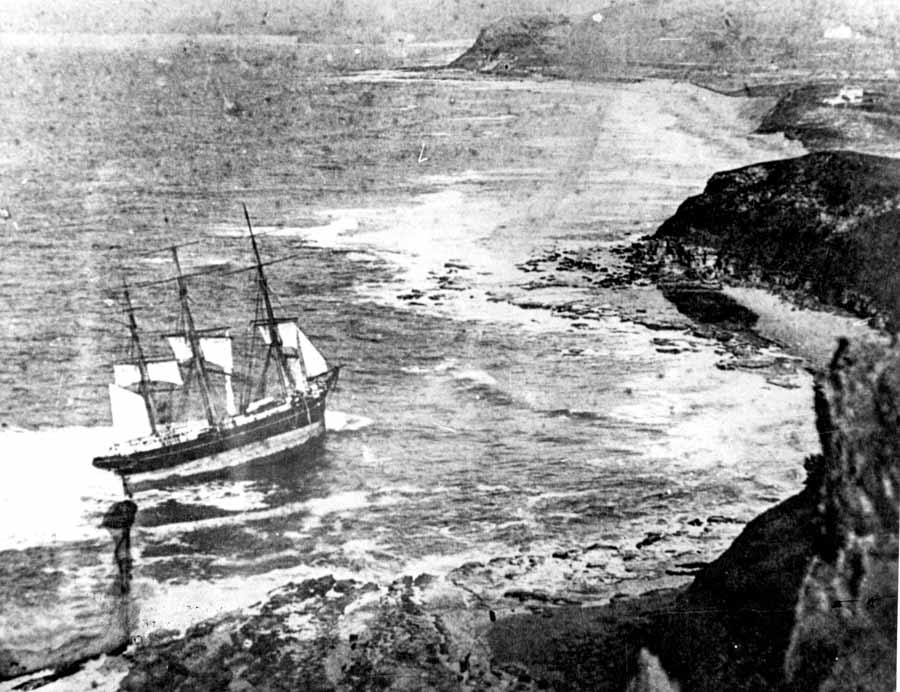
I also remember seeing the steamer Age – Messrs Howard Smith’s boat – lying alongside the flat rocks about 1/4 mile the town side of Shepherds Hill. She came there in a fog. I also saw her under her own steam leave the rocks and come into Newcastle Harbour. As far as I remember she was seaworthy.
There was no road (only by winding Coal Road) between the two pits at the Borehole as Hamilton was then known. Number 1 Pit was about 100 feet east away from the present racecourse gate where they take the race horses in to train at Beckett Street entrance and the Number 2 Pit was near the hill at Beaumont Street, Glebe, as you go towards Adamstown from Gordon Avenue South and the end of Macquarie Street.
The bush extended from the west side and south side of the old racecourse from The Junction to Newcastle and to Adamstown. The only other track to Lake Macquarie was a very winding bush track over Camerons Hill Borehole through Adamstown on the west side of the hill off where the tram line goes through to Adamstown.
I remember when it was bushland from Packer Street right through to Borehole (now Hamilton). Also from Denison Street, Maitland Road to Cameron Street, Borehole, east of Tudor Street; also to Turner Street, Hamilton, and the south side of Denison Street to Beaumont Street. I remember a terrace of miners’ cottages on the Hill (Camerons) – about Samdon Street – above the fire station at Borehole.
Also the old air shaft on the south side of Winship Street and the homestead for the Engineer. There were no other houses – only Mr James Cameron’s Queen’s Arms Hotel and Mr Thomas’s Tudor Hotel and a small wooden Church of England. I remember going to a meeting there. Rev F. D. Bode was the Minister of St Johns and St Peters.
From Mr Cameron’s Hotel to New Lambton and across to Hanbury (Waratah) it was thick bush. Also I have seen bush across Broadmeadow from Goninans right through to Georgetown to where the brickyards are now. Below the Benevolent Asylum was thick bush and high trees only a bush track. I travelled across there with my brothers.
I have been through Islington when it was only a bush track with trees on either side and bullock paddocks also both sides of Maitland Road to Hexham.
Mr Sneesby’s postscripts . . .
I remember Mr J. Winship who was the manager for the A.A. Coy. He lived in a cottage overlooking Darby Street where the late Mr Joseph Wood built his home and lived. This is now Alluker [Iluka?} Hospital.
Mr Winship rode on a bay horse with a short white-handled whip he carried and he went along the old Railway line which when to Hamilton Pit. Every morning I would see him, as my brothers and I sat looking off Dart’s Hill and Prosser’s Hill. He lost his life as he was coming from Melbourne with the late Mr F. Ash in the Dandenong in September, 1876. Mr F. Ash was saved. He ventured in a small rowing boat from the steamer to a barque that was not far away but Mr Winship would not go with him. A big southerly gale was raging and the propeller snapped off and caused a hole in the steamer.
I remember the first buses to run in Newcastle. I remember seeing and hearing the late James Cameron Junior as a call-boy on his father’s buses. Also Mr T. Tudor Snr and Mr McAuliffe. The buses only ran to Hamilton and Junction and later Mr Morris’s Hotel at Tighes Hill (he was the pioneer for that suburb, as Messrs Cameron, Tudor and McAuliffe were for Hamilton and The Junction).
Honeysuckle Railway Station was first built opposite Auckland Street. I remember going to a Sunday School Picnic (St Johns) and we entrained from that station. I have a ticket dated 1872.
Where the terrace of shops near the Cooke clothing Co and east – nearly opposite Messrs Palings warehouse – the footpath was three feet above the street. There were one-storey brick shops – very small. Mr and Mrs Webb (Mr George Webb’s father and mother) kept one of the shops as a fancy goods, wools, etc. Mr H. Webb was the captain of the fire brigade. Also Mr Schumaker had a barbers shop, the Miss Fogartys a Drapers shop on the corner of Newcomen and Hunter Street.
Mr William Arnott had a bakers shop at the corner of Hunter and Wolfe Streets where the late Messrs Green Bros’ new premises were built and later made into a milk bar. I saw Mr and Mrs Arnott both serve in the shop and I was served by them. I might say next-door the late Mr McLardy had a poultry and smallgoods shop.

